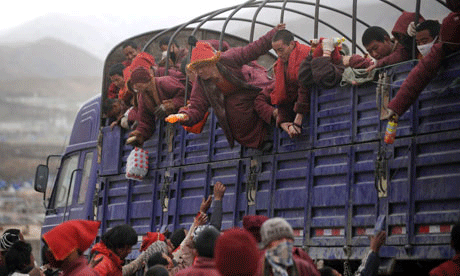
Chinese officials have ordered some monasteries to recall monks from the western town devastated by an earthquake last week.
Buddhist lamas have played a crucial role in rescue and relief operations in Jiegu, an overwhelmingly Tibetan town in Qinghai province. Thousands have dug for survivors in the rubble, disposed of bodies and arranged food and shelter for the homeless.
More than 2,180 people died in the 14 April earthquake and 12,000 were injured.
Yixi Luoren, the head of Gengqing monastery, said 120 of the 150 monks who went to Yushu county had left on the orders of officials in the monastery’s home prefecture of Ganzi, an area known for its strong Tibetan identity.
“The authorities didn’t tell us the reason but we assume they might have worried that there are too many people there and wanted us to come home safely,” he said.
Woeser, a Beijing-based Tibetan poet and activist, said Han and Tibetan acquaintances reported similar orders being given to other monks. “A clear reason for the order wasn’t given but it was very strict,” he said.
“Local officials told them through translators in Tibetan: ‘You’ve done everything already. You’ve done too much. You have to leave Yushu now, otherwise there will be trouble.'”
Other lamas were still at work, said a monk from the Sershul monastery in Sichuan, which sent hundreds to help.
“Some of the monks have returned because the rescue work is reaching an end but others are still in the quake zone delivering food,” said the monk.
He said they had not received orders to leave. Those who did were holding rites for the dead at the monastery and arranging further aid.
A spokesman for the ministry of civil affairs told a press conference in Beijing that he was not aware of an order for monks to leave.
“After the disaster happened the central government brought in a large number of rescuers while lots of monks also participated, which can be seen in many media reports,” said Peng Chenmin.
“It’s a good thing, which represents the spirit of ethnic unity.”
Professor Robert Barnett, director of the modern Tibetan studies program at Columbia University, said: “China has never faced this situation before, where the monks it has demonised for 15 years as potential enemies of the state turn out to be energetic contributors to social construction and community building, the same role that the party has always claimed for itself.
“There is an opportunity here for the state finally to recognise the immense cultural resources that the monks can offer.
“But it will take great cultural sensitivity and compromise on both sides for that to be achieved.”
State media have focused on the efforts of the military and the armed police in tackling the disaster, leading Tibetans to complain that monks have not received sufficient credit.
CCTV, the official broadcaster, is thought to have shown lengthy footage of monks at work on the day of the disaster, but little since then. Wen Jiabao, the Chinese premier, praised the work of lamas as he toured a destroyed monastery, although Reuters reported that state media did not cover the visit.
The state news agency Xinhua reported today that three centimetres of snow had fallen on Yushu by 8am, with more expected in coming days.
“We have experienced extreme weather: sandstorms, hail and now snow,” said Aman Yee, an Oxfam worker in the town.
“We are lucky that materials have already arrived on site but it has caused difficulties with distribution.
“Those who are elderly or who have been injured or are bereaved may not be going out to collect supplies, so local NGOs are going to find them.
“We would also like to purchase some local food like tsampa [the roasted, powdered barley which is a staple foodstuff for Tibetans]. At the moment people are eating instant noodles and they are not used to it, so it can affect their stomachs.”
Source : http://www.guardian.co.uk




